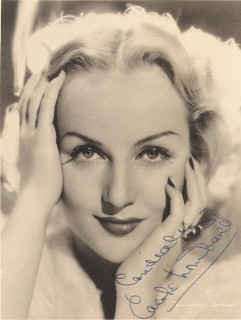Carole Lombard (Jane Alice Peters)

Carole Lombard
was an American film actress. She was particularly noted for her highly neurotic, energetic and often off-beat roles in the screwball comedies of the 1930s. She was the highest-paid star in Hollywood in the late 1930s.
Lombard was born into a wealthy family in Fort Wayne, Indiana, on October 6, 1908. She attended Virgil Junior High School, where she excelled in sports, and while playing baseball caught the attention of the film director Allan Dwan, which led to her screen debut in A Perfect Crime (1921). In October 1924, at the age of 16, she signed a contract with the Fox Film Corporation, and got her first break the following year opposite Edmund Lowe in the successful drama Marriage in Transit. She was dropped by Fox after a car accident that left a scar on her face. Lombard appeared in 15 short films of Pathé Exchange between September 1927 and March 1929, and then began appearing in feature films such as High Voltage and The Racketeer. After a successful one-off appearance opposite Warner Baxter in Fox’s The Arizona Kid, she signed a contract with Paramount Pictures who cast her in the Buddy Rogers comedy Safety in Numbers (1930).
Lombard began appearing in comedies with William Powell such as Man of the World and Ladies Man, and married him in June 1931. The marriage to Powell increased Lombard’s fame, and the two would continue to occasionally star together throughout the 1930s, despite being divorced in 1933. Lombard starred alongside Clark Gable (whom she married in 1939) in No Man of Her Own (1932) and George Raft in Bolero (1934), where her dance skills were praised. After roles in successful films such as Twentieth Century (1934), Hands Across the Table (1935), which was the first of four comedies made with Fred MacMurray, The Princess Comes Across (1936), My Man Godfrey (1936), which won her an Academy Award nomination opposite Powell, Swing High, Swing Low (1937), and Nothing Sacred (1937), Lombard had become the highest-paid actress in Hollywood and one of its most popular stars. Eager to win an Oscar, by the end of the decade she began to move away from comedies towards more serious roles, appearing opposite James Stewart in the drama Made for Each Other (1939) and alongside Cary Grant in the romance In Name Only (1939). Her role as a nurse in Vigil in the Night was her most notable attempt to win an Oscar but didn’t receive a nomination. Lombard returned to comedy in Alfred Hitchcock‘s Mr. & Mrs. Smith in 1941.
Lombard’s career was cut short when she died at the age of 33 in an aircraft crash on Mount Potosi, Nevada while returning from a World War II War Bond tour. Her final film, Ernst Lubitsch‘s To Be or Not to Be (1942), a satire about Nazism and the war, was in post-production at the time of her death. Today she is remembered as one of the definitive actresses of the screwball comedy genre and American comedy, and ranks among the American Film Institute‘s greatest stars of all time. The World War II Liberty Ship SS Carole Lombard and the Carole Lombard Memorial Bridge over the St. Mary’s River in Fort Wayne were named after her.
Born
- October, 06, 1908
- Fort Wayne, Indiana
Died
- January, 16, 1942
- Mount Potosi, Nevada
Cause of Death
- Plane Crash
Cemetery
- Forest Lawn Memorial Park
- Glendale, California



